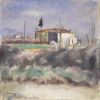The Collection
Lo sguardo di Morandi tra Bologna e Grizzana
In this room can be seen several landscapes that Morandi painted (in oils and watercolours), drew, and engraved in the two places in which he spent the greater part of his life, Bologna and Grizzana.
Looking out from his studio in via Fondazza – or, more precisely, from that studio’s single window – his gaze lingered on the walls of several nearby houses and on a tiny courtyard, with a plot of earth at its centre in which grew an olive tree (which he painted and engraved only once). This window represented for him a threshold opening on to the surrounding world, and the view of “The Courtyard in Via Fondazza” became, from the 1930s onwards, the subject he depicted most often (the general catalogue of his works includes more than forty paintings of it, along with eight watercolours and thirteen drawings). In the canvases of this period Morandi captures a detail of the courtyard, focusing his attention on the greenery and positioning the roofs of the houses opposite at an unusual angle. Later, his point of view would expand, eventually coming to incorporate the whole set of those buildings, with their clearly-outlined geometrical shapes, further emphasized by contrasts of light and shade on their honey-coloured walls and their roofs of old rose.
In 1959, by which time the view of the courtyard in via Fondazza had become overshadowed by newly-erected blocks of flats, the artist decided to build himself a house at Grizzana, directly across from two farmhouses known as the “del Campiaro” houses. The solid geometrical form of these rustic buildings had been of special interest to Morandi during the 1940s (though some engravings from 1929 form an exception to this rule), when he painted and engraved them, most often from a diagonal perspective, perched high on the edge of the white road that often takes centre stage in the composition. On the other hand, in his last summers at Grizzana Morandi experimented with some rare foreshortened images of the del Campiaro houses, seen in directly frontal view and from very close up, through a process of transfiguration in which the buildings’ perfectly calculated volume appears to be flattened out and almost absorbed into the flat surface of the canvas or the sheet of paper.







